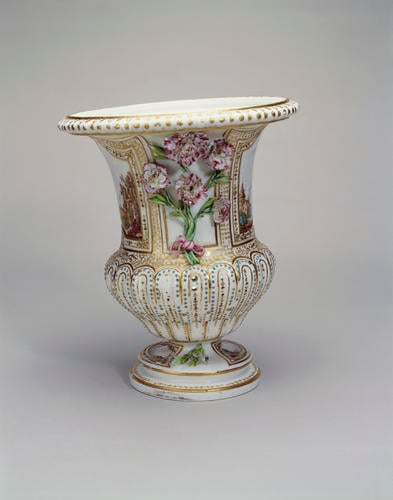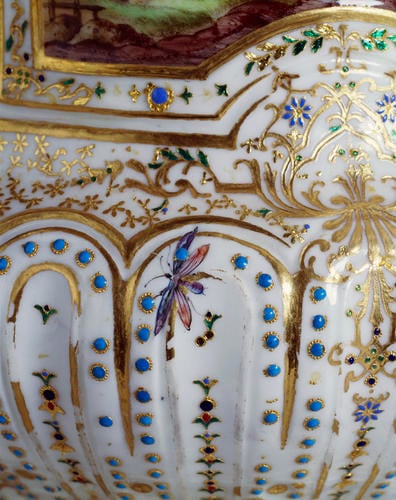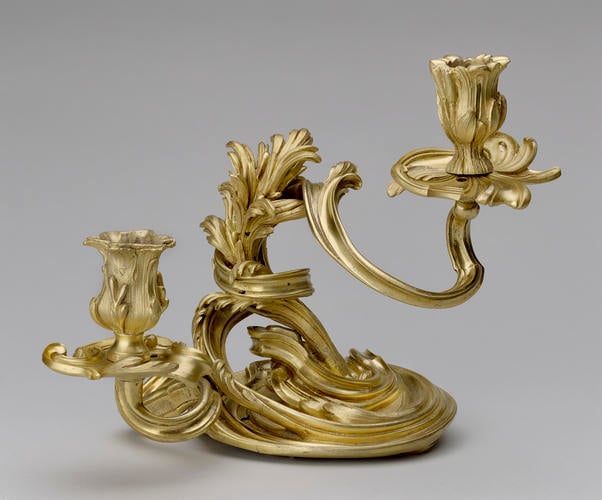-
1 of 253523 objects
The Sunflower clock c. 1752
105.4 x 66.7 x 54.0 cm (whole object) | RCIN 30240







-
A gilt bronze clock in the form of a sunflower, mounted into the centre of a Vincennes porcelain urn shape vase containing a bouquet of flowers, also of Vincennes porcelain, on stems of green laquered brass wire.
Arranged as a loose bouquet, the porcelain flowers surround a Sunflower Clock which dates from the early 1750s. The clock’s dial replicates the centre of a sunflower, a symbol of the Sun King, Louis XIV. Although Louis XIV had died 40 years before the production of the clock, his enduring influence over French court life was highlighted by the retention of many of his interiors at Versailles, and even at the Petit Trianon.
The clock face is formed by brass shavings and gold-painted bars for figures: the hours are in roman numerals and the minutes, in multiples of five, in arabic numerals. The pendulum regulation hole is above and to the right of I, and the winding holes are without III and VII.
The movement, which has circular plates, is powered by two going barrels which are larger than the barrel wheels. This unusual movement has an articulated cross escapement driving a short pendulum hung on silk. The pendulum is set in motion by operating a lever at the base of the clock. The count-wheel is of traditional design striking the hours and half-hour on a bell below the movement. Jean Benoît Gérard (d.1781) became a maître in 1743 but continued to work with his father, Benoît II until he died in 1758. He retained his father's signature and was listed as having premises on the quai des Grands Augustins (1746) and the rue Saint André-des-Arts (1772). He wound up the business in 1777.
The ensemble is essentially a curiosity. The clock is surrounded by porcelain flowers on stems, which have the appropriate leaves for their flower. Natural flowers were sometimes mingled with the porcelain examples, and as the porcelain bouquet surrounding the clock can be entirely removed, it is possible that the porcelain flower stems were placed in the vase over the winter, to be replaced with real specimens during the summer months.
The vessel is an elaborately scrolled, asymmetrical terrace in gilt bronze, the Vincennes vase, with painted scenes recalling those of early Meissen porcelain.
The original piece was enhanced in the early nineteenth century. The additions include the gilt bronze snake handles, the twin-branch candelabra, the drum supporting the vase and an assortment of later porcelain flowers of German and English origin.
Of particular interest is the jewelling on the vase, which in places can be seen to overlay the original Vincennes painted insects and moths.
Notwithstanding these enrichments, the assemblage retains much of its former glory and remains an astonishing creation, to which potters at Vincennes, bronze manufacturers and a clock-maker all contributed.
Text adapted from French Porcelain for English Palaces, Sèvres from the Royal Collection, London, 2009 and Painting Paradise: The Art of the Garden, London, 2015.
Provenance
Bought in Paris in November 1819, almost certainly by François Benois for King George IV, for 5,500 francs: ‘1 Vaze de Porcelaine de Sevres Richement montés en Bronze Doré et fleurs en Porcelaine avec un soleil Dans le Centre Contenant une Pendule’. Its receipt at Carlton House is recorded by Benjamin Jutsham on 25 November 1819: ‘A Porcelaine Vase of White Ground, with ornamental Paintings on it. Mounted upon an Ancient Or Molu Stand in Scrolls &c. the Vase contains A Quantity of Flowers of Various Descriptions, formed of Dresden Porcelaine. in the Centre of the Flowers is placed an Ormoulu Sun Flower, to Act as a Clock. the Or Moulu Stand has Branches for Light (Remarks) This Article is Said to have belonged to Madame Pompadore. it is in the Anti Room below.’ It remained in this room until the palace was emptied of its contents in late 1826/early 1827 prior to the demolition of Carlton House in 1827. Valued at £54.
Included in the Pictorial Inventory of 1827-33 – RCIN 9347784 The inventory was originally created as a record of the clocks, vases, candelabra and other miscellaneous items from Carlton House, as well as selected items from the stores at Buckingham House, the Royal Pavilion, Brighton, Hampton Court and Kensington Palace for consideration in the refurbishment of Windsor Castle. -
Creator(s)
(porcelain manufacturer)(clockmaker)(metalworker)(nationality)Acquirer(s)
-
Medium and techniques
Measurements
105.4 x 66.7 x 54.0 cm (whole object)
30 x 13.9 cm (diameter)
Object type(s)
Other number(s)
Alternative title(s)
Vase Le Boitteux
Mantel clock
Place of Production
Vincennes [France]